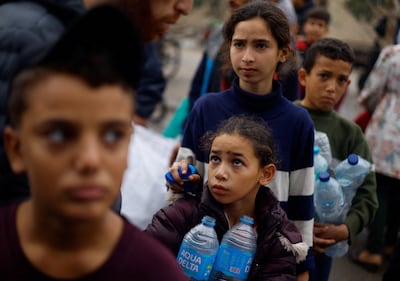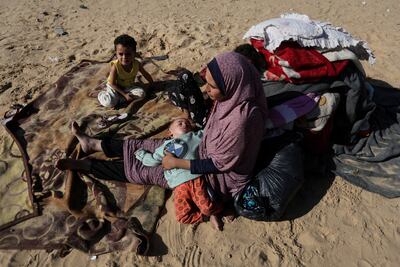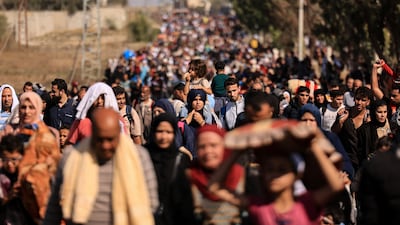Live updates: Follow the latest news on Israel-Gaza
Little Marah cries on the surgery table in a hospital in the ravaged Gaza Strip as doctors try to save her injured right ear. Despite the pain, she still hopes it's just a dream.
“I want to ask you something,” she says, struggling to speak clearly. “Is this a dream, or is this real?” The doctor responds by telling her that she is okay. But the answer isn't enough.
“I know I am alive. But is this a dream? Or is this a reality?”
Two months of relentless Israeli strikes and fighting following the Hamas attacks on Israel on October 7, have killed more than 16,200 Palestinians in the coastal enclave, including over 7,000 children.
Entire neighbourhoods have been destroyed, and the heavy bombardment has reduced Gaza city, the centre of the enclave, to an “unlivable” condition.
The city's mayor Yahya Al Sarraj told The National that public areas, residential buildings, libraries, schools, shelters, parks, green areas, cultural venues, children’s centres – “everything that made people happy” have been destroyed, turning Gaza into a “wasteland”.
“It is so severe. It is unbelievable,” Mr Al Sarraj said of the Strip that covers a mere 365 square kilometres and is often compared to an open-air prison due to Israel’s control of its borders and seas.
The 65-year-old mayor, who took charge in 2019, explained that he had seen many wars in Gaza but not one “quite as deadly” as the current one.
“It is horrific what has happened to the city in just 60 days. The scale of destruction they unleashed on a city inhabited by people is beyond imagination.”
The two-month-long war has been dubbed as one of the most “destructive” wars in the Israeli-Palestinian conflict. According to the UN’s humanitarian office, at least 45 per cent of all homes have been damaged or destroyed by the Israeli attacks.
Israel’s military campaign after Hamas’ attacks, which killed about 1,200 people, has pushed the city’s 2.3 million people into a “humanitarian abyss”.
Israel cut off water and electricity to Gaza, which the UN and international aid agencies described as a “collective punishment”.
Gaza does not look like a city under war. It is more like an Israeli destruction machine was unleashed on the city. There is nothing left."
Yahya Al Sarraj,
Gaza Mayor
Mr Al Sarraj said the one-week truce under a Qatar-negotiated prisoner and hostage exchange deal that ended on December 1 gave the civic body the first opportunity to assess the extent of damage to Gaza city.
What they saw was “indescribable”, according to the mayor, who has lost his own home.
“Gaza does not look like a city under war. It is more like an Israeli destruction machine was unleashed on the city. There is nothing left.”
No water to drink
On November 24, when the temporary truce was announced and the guns fell silent, the first task of Gaza city's emergency response committee was to supply water to the besieged population.
“We lost almost 90 per cent of our water resources in the bombing. Water wells cannot be operated as we don’t have the fuel to run generators,” Mr Al Sarraj explained.
Overflowing sewage due to untreated waste is polluting the city and creating a health hazard for people who are already living under constant bombardment.
“The main waste water lagoon is already full. These lagoons will flood into houses unless we clear it,” he said.
With the halt of essential services and the lack of clean drinking water, the city is facing a health disaster with the fear of the imminent spread of diseases.
“It will be a catastrophe,” emphasised the mayor.
The World Health Organisation has warned that there could be more deaths in Gaza from disease than from bombs and missiles.
With the resumption of fighting, Israeli forces are pushing ahead with their ground incursion and bombardment of southern and central Gaza.
Thousands of families are once more fleeing fighting as Israel steps up its attacks on the cities of Khan Younis and Deir Al Balah.
Mr Al Sarraj said the municipality is struggling to deliver the basic services as fighting continues.
He said two solid waste dumping stations have been on fire for the past two weeks due to Israeli missiles igniting those areas.
“The fires have been raging for the past 15 days, rendering neighbourhoods uninhabitable.”
The municipality's fire fighting equipment was destroyed during the conflict, making extinguishing the blazes impossible.
“We lost around 75 medium and heavy equipment and machinery as well 12 of our employees,” he added.
'Never lived through such hardship'
With the bombardment moving from one area to another, hundreds of thousands of Gazans fled their homes and took shelter in schools and hospitals, sleeping in classrooms and X-ray rooms.
Among those is Haj Omar Al Astal, who described his life and that of his family as “hell on earth” as they left their southern hometown of Khan Younis, which was once declared a safe haven by Israeli forces but is now the target of its fiercest aggression.
The family were forcibly displaced from their homes in Satr in northern Khan Younis earlier this week. Israeli forces pelted them with leaflets warning them to evacuate before rolling their tanks into the southern part of the enclave, which had been declared a safe zone when the attack on Gaza started two months ago.
With virtually nowhere to go, more than 80 people have been pushed to Al Mawasi, a narrow agricultural and fishing strip of coastal land one kilometre wide and 14 kilometres long. “I've never lived through such hardship,” 74-year-old Mr Al Astal told The National, tears welling up in his eyes.
According to the UN humanitarian office OCHA, 1.93 million Gazans have been internally displaced – more than 81 per cent of the enclave’s population.
In the wilderness of Al Mawasi, some of the men replaced the cucumber greenhouses with four tents, and erected wooden structures covered in fabric to build a makeshift outhouse.
A mound of stones and some wood they collected as they walked away from their homes has become their kitchen. A plastic container that they filled from a nearby agricultural well is the only water they have; a little flour and some canned goods are their only food.
Ahmed Haidar, his wife, mother, and two young daughters narrowly escaped the bombardment of a neighbouring house in the centre of Khan Younis, fleeing his home just as Israeli tanks rolled in, metres away.
Residents of Gaza city have been displaced four times in the past 60 days, ultimately joining a growing number of internally-displaced people seeking refuge in Al Mawasi.
Having walked for hours, a vehicle heading their way gave them a lift to this barren part of the besieged strip. They spent the night on the street, using plastic bags they found along the way to shield themselves from the rain and dropping temperatures.
“We are in a hell that no human can endure,” Mr Haidar told The National.
Even animals are not safe
Mr Al Sarraj explained the devastating impact of the Israeli bombardment on Gaza, saying even animals in the local zoo were not spared.
“We lost more than 60 per cent of the animals; they were starved to death after caretakers were forced to abandon them.”
The animals included hyenas, wolves, foxes, donkeys, dogs, birds, and monkeys, discovered by zoo workers when they returned during the temporary truce.
“We have a lion, which is a big attraction in the zoo, and luckily, he survived, though he has not eaten anything in three weeks.”
The mayor said the zoo workers tried their best to feed the surviving animals with whatever was available.
“But where is the food and water?” he asked.
This article was written in collaboration with Egab.
Squid Game season two
Director: Hwang Dong-hyuk
Stars: Lee Jung-jae, Wi Ha-joon and Lee Byung-hun
Rating: 4.5/5
THE BIO
BIO:
Born in RAK on December 9, 1983
Lives in Abu Dhabi with her family
She graduated from Emirates University in 2007 with a BA in architectural engineering
Her motto in life is her grandmother’s saying “That who created you will not have you get lost”
Her ambition is to spread UAE’s culture of love and acceptance through serving coffee, the country’s traditional coffee in particular.
The%20specs
%3Cp%3E%3Cstrong%3EEngine%3A%20%3C%2Fstrong%3E3.6-litre%2C%20V6%0D%3Cbr%3E%3Cstrong%3ETransmission%3A%20%3C%2Fstrong%3Eeight-speed%20auto%0D%3Cbr%3E%3Cstrong%3EPower%3A%20%3C%2Fstrong%3E285hp%0D%3Cbr%3E%3Cstrong%3ETorque%3A%20%3C%2Fstrong%3E353Nm%0D%3Cbr%3E%3Cstrong%3EPrice%3A%20%3C%2Fstrong%3EDh159%2C900%0D%3Cbr%3E%3Cstrong%3EOn%20sale%3A%20%3C%2Fstrong%3Enow%3C%2Fp%3E%0A
VEZEETA PROFILE
Date started: 2012
Founder: Amir Barsoum
Based: Dubai, UAE
Sector: HealthTech / MedTech
Size: 300 employees
Funding: $22.6 million (as of September 2018)
Investors: Technology Development Fund, Silicon Badia, Beco Capital, Vostok New Ventures, Endeavour Catalyst, Crescent Enterprises’ CE-Ventures, Saudi Technology Ventures and IFC
Results
6.30pm: The Madjani Stakes (PA) Group 3 Dh175,000 (Dirt) 1,900m
Winner: Aatebat Al Khalediah, Fernando Jara (jockey), Ali Rashid Al Raihe (trainer).
7.05pm: Maiden (TB) Dh165,000 (D) 1,400m
Winner: Down On Da Bayou, Royston Ffrench, Salem bin Ghadayer.
7.40pm: Maiden (TB) Dh165,000 (D) 1,600m
Winner: Dubai Avenue, Fernando Jara, Ali Rashid Al Raihe.
8.15pm: Handicap (TB) Dh190,000 (D) 1,200m
Winner: My Catch, Pat Dobbs, Doug Watson.
8.50pm: Dubai Creek Mile (TB) Listed Dh265,000 (D) 1,600m
Winner: Secret Ambition, Tadhg O’Shea, Satish Seemar.
9.25pm: Handicap (TB) Dh190,000 (D) 1,600m
Winner: Golden Goal, Pat Dobbs, Doug Watson.
Mercer, the investment consulting arm of US services company Marsh & McLennan, expects its wealth division to at least double its assets under management (AUM) in the Middle East as wealth in the region continues to grow despite economic headwinds, a company official said.
Mercer Wealth, which globally has $160 billion in AUM, plans to boost its AUM in the region to $2-$3bn in the next 2-3 years from the present $1bn, said Yasir AbuShaban, a Dubai-based principal with Mercer Wealth.
“Within the next two to three years, we are looking at reaching $2 to $3 billion as a conservative estimate and we do see an opportunity to do so,” said Mr AbuShaban.
Mercer does not directly make investments, but allocates clients’ money they have discretion to, to professional asset managers. They also provide advice to clients.
“We have buying power. We can negotiate on their (client’s) behalf with asset managers to provide them lower fees than they otherwise would have to get on their own,” he added.
Mercer Wealth’s clients include sovereign wealth funds, family offices, and insurance companies among others.
From its office in Dubai, Mercer also looks after Africa, India and Turkey, where they also see opportunity for growth.
Wealth creation in Middle East and Africa (MEA) grew 8.5 per cent to $8.1 trillion last year from $7.5tn in 2015, higher than last year’s global average of 6 per cent and the second-highest growth in a region after Asia-Pacific which grew 9.9 per cent, according to consultancy Boston Consulting Group (BCG). In the region, where wealth grew just 1.9 per cent in 2015 compared with 2014, a pickup in oil prices has helped in wealth generation.
BCG is forecasting MEA wealth will rise to $12tn by 2021, growing at an annual average of 8 per cent.
Drivers of wealth generation in the region will be split evenly between new wealth creation and growth of performance of existing assets, according to BCG.
Another general trend in the region is clients’ looking for a comprehensive approach to investing, according to Mr AbuShaban.
“Institutional investors or some of the families are seeing a slowdown in the available capital they have to invest and in that sense they are looking at optimizing the way they manage their portfolios and making sure they are not investing haphazardly and different parts of their investment are working together,” said Mr AbuShaban.
Some clients also have a higher appetite for risk, given the low interest-rate environment that does not provide enough yield for some institutional investors. These clients are keen to invest in illiquid assets, such as private equity and infrastructure.
“What we have seen is a desire for higher returns in what has been a low-return environment specifically in various fixed income or bonds,” he said.
“In this environment, we have seen a de facto increase in the risk that clients are taking in things like illiquid investments, private equity investments, infrastructure and private debt, those kind of investments were higher illiquidity results in incrementally higher returns.”
The Abu Dhabi Investment Authority, one of the largest sovereign wealth funds, said in its 2016 report that has gradually increased its exposure in direct private equity and private credit transactions, mainly in Asian markets and especially in China and India. The authority’s private equity department focused on structured equities owing to “their defensive characteristics.”
Low turnout
Two months before the first round on April 10, the appetite of voters for the election is low.
Mathieu Gallard, account manager with Ipsos, which conducted the most recent poll, said current forecasts suggested only two-thirds were "very likely" to vote in the first round, compared with a 78 per cent turnout in the 2017 presidential elections.
"It depends on how interesting the campaign is on their main concerns," he told The National. "Just now, it's hard to say who, between Macron and the candidates of the right, would be most affected by a low turnout."
Results
6.30pm Madjani Stakes Rated Conditions (PA) I Dh160,000 I 1,900m I Winner: Mawahib, Tadhg O’Shea (jockey), Eric Lemartinel (trainer)
7.05pm Maiden Dh150,000 I 1,400m I Winner One Season, Antonio Fresu, Satish Seemar
7.40pm: Maiden Dh150,000 I 2,000m I Winner Street Of Dreams, Pat Dobbs, Doug Watson
8.15pm Dubai Creek Listed I Dh250,000 I 1,600m I Winner Heavy Metal, Royston Ffrench, Salem bin Ghadayer
8.50pm The Entisar Listed I Dh250,000 I 2,000m I Winner Etijaah, Dane O’Neill, Doug Watson
9.25pm The Garhoud Listed I Dh250,000 I 1,200m I Winner Muarrab, Dane O’Neill, Ali Rashid Al Raihe
10pm Handicap I Dh160,000 I 1,600m I Winner Sea Skimmer, Patrick Cosgrave, Helal Al Alawi
Ten tax points to be aware of in 2026
1. Domestic VAT refund amendments: request your refund within five years
If a business does not apply for the refund on time, they lose their credit.
2. E-invoicing in the UAE
Businesses should continue preparing for the implementation of e-invoicing in the UAE, with 2026 a preparation and transition period ahead of phased mandatory adoption.
3. More tax audits
Tax authorities are increasingly using data already available across multiple filings to identify audit risks.
4. More beneficial VAT and excise tax penalty regime
Tax disputes are expected to become more frequent and more structured, with clearer administrative objection and appeal processes. The UAE has adopted a new penalty regime for VAT and excise disputes, which now mirrors the penalty regime for corporate tax.
5. Greater emphasis on statutory audit
There is a greater need for the accuracy of financial statements. The International Financial Reporting Standards standards need to be strictly adhered to and, as a result, the quality of the audits will need to increase.
6. Further transfer pricing enforcement
Transfer pricing enforcement, which refers to the practice of establishing prices for internal transactions between related entities, is expected to broaden in scope. The UAE will shortly open the possibility to negotiate advance pricing agreements, or essentially rulings for transfer pricing purposes.
7. Limited time periods for audits
Recent amendments also introduce a default five-year limitation period for tax audits and assessments, subject to specific statutory exceptions. While the standard audit and assessment period is five years, this may be extended to up to 15 years in cases involving fraud or tax evasion.
8. Pillar 2 implementation
Many multinational groups will begin to feel the practical effect of the Domestic Minimum Top-Up Tax (DMTT), the UAE's implementation of the OECD’s global minimum tax under Pillar 2. While the rules apply for financial years starting on or after January 1, 2025, it is 2026 that marks the transition to an operational phase.
9. Reduced compliance obligations for imported goods and services
Businesses that apply the reverse-charge mechanism for VAT purposes in the UAE may benefit from reduced compliance obligations.
10. Substance and CbC reporting focus
Tax authorities are expected to continue strengthening the enforcement of economic substance and Country-by-Country (CbC) reporting frameworks. In the UAE, these regimes are increasingly being used as risk-assessment tools, providing tax authorities with a comprehensive view of multinational groups’ global footprints and enabling them to assess whether profits are aligned with real economic activity.
Contributed by Thomas Vanhee and Hend Rashwan, Aurifer
Paris Can Wait
Dir: Eleanor Coppola
Starring: Alec Baldwin, Diane Lane, Arnaud Viard
Two stars
Turning%20waste%20into%20fuel
%3Cp%3EAverage%20amount%20of%20biofuel%20produced%20at%20DIC%20factory%20every%20month%3A%20%3Cstrong%3EApproximately%20106%2C000%20litres%3C%2Fstrong%3E%3C%2Fp%3E%0A%3Cp%3EAmount%20of%20biofuel%20produced%20from%201%20litre%20of%20used%20cooking%20oil%3A%20%3Cstrong%3E920ml%20(92%25)%3C%2Fstrong%3E%3C%2Fp%3E%0A%3Cp%3ETime%20required%20for%20one%20full%20cycle%20of%20production%20from%20used%20cooking%20oil%20to%20biofuel%3A%20%3Cstrong%3EOne%20day%3C%2Fstrong%3E%3C%2Fp%3E%0A%3Cp%3EEnergy%20requirements%20for%20one%20cycle%20of%20production%20from%201%2C000%20litres%20of%20used%20cooking%20oil%3A%3Cbr%3E%3Cstrong%3E%E2%96%AA%20Electricity%20-%201.1904%20units%3Cbr%3E%E2%96%AA%20Water-%2031%20litres%3Cbr%3E%E2%96%AA%20Diesel%20%E2%80%93%2026.275%20litres%3C%2Fstrong%3E%3C%2Fp%3E%0A



















